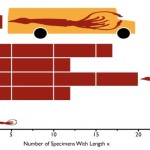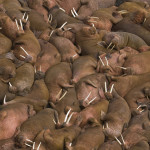
From JAMSTEC, Chimney of “Blue Smoker” at a depth of 1470 m
Just Science Entry #3
Hydrothermal vents appear from ruptures in the newly created basalt along mid-oceanic ridges. At fractures the surrounding cold water penetrates the crust and mix with red-hot basalt. This mixture emerges through three types of hot springs seafloor.
In some cases the liquid simply emerges through a crack or crevice at temperatures ranging from a cool? 5-250 degrees C. At black smokers (270-380 degrees C) and white smokers (100-300 degrees C) the vent liquid is hotter The vent liquid emerges forming structures from precipitated minerals that collect due to the surrounding low temperature and extreme pressure. At black smokers water causes the metal- and sulfide-rich, acidic fluid to mix with cold, basic seawater. This causes the metals to precipitate. At white smokers, the cooler temperature don’t allow metal precipitates to form, instead silica, anhydrite, and barite precipitate. At black smokers the precipitates can create 10-20m high columns (chimneys). Sometimes on the sides and tops of chimneys, beehive type formations can occur or flanges (think shelf mushrooms on a tree).
Researchers at JAMSTEC (Japan Agency for Marine-Earth Science and Technology) have recently added another vent type, Blue Smoker.

From JAMSTEC, Blue hydrothermal emission (“Blue Smoker”)
The feature was videotaped by chance in August 2006, when JAMSTEC researchers were diving aboard their deep-sea research submersible Shinkai 6500, on a press jaunt with a television crew. In a lava dome in the Okinawa Trough, 1,470 metres deep in the southern waters of Japan, where clear, hot fluid was bubbling out of the sea floor, the researchers caught on film the sudden, unexpected emergence of white and blue smoke. The colour change is undoubtedly due to a change in chemistry in the water, probably caused by a change in magma activity below. But why it is blue, and what that means for researchers’ understanding of hotspots, is unclear.






Unfortunately, I needed to be a “premium” subscriber to access the article, which Penn State does not qualify as. I am curious to how prevalent the blue smoke is at other vent edifices in the Okinawa Trough or whether it is an isolated incident. Could it be possible that the blue is coming from high concentrations of Cobalt, Chromium or Copper?